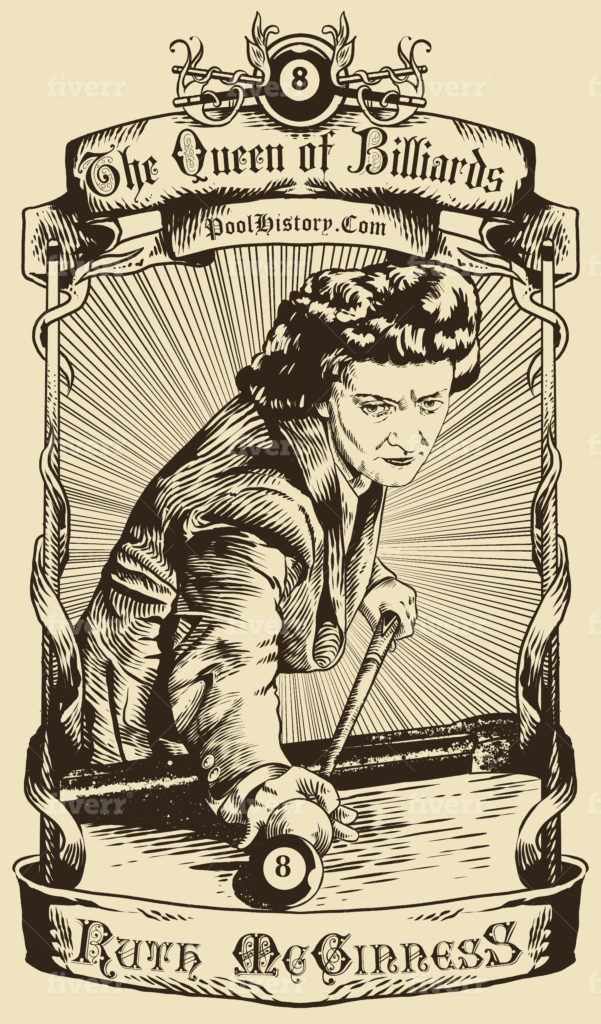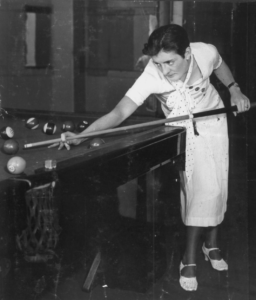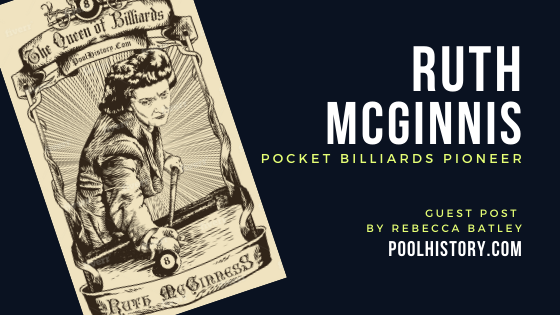Ruth McGinnis was America’s first great female pool professional.
Rebecca Batley/Guest Contributor
In her skirt, blouse and smart midi heels, Ruth McGinnis did not look like your typical pool shark. Playing pool in a skirt is not the easiest of things to do — it does not allow the player to ‘sprawl’ over the table, nor to lean too far over. Neither was the early twentieth century American pool hall the easiest of places for a woman with sporting ambitions.

But McGinnis overcame those obstacles and more en route to becoming America’s first truly great female pool star. The pool room had long been a bastion of male, macho culture. But with talent and ambition she persevered.
McGinnis was born in 1910 to a working class family in Honesdale, Pennsylvania. It was at her family’s barbershop on South Main Street — complete with two pool tables to keep customers entertained — that she first tried her hand at the game of straight pool. She immediately showed a great aptitude for it.
At age 10 she ran a 47, something many players don’t manage their entire lives. By age 11 she already was performing local exhibitions. At age 13 she was described as “a pocket player of exceptional ability” by a well known veteran. Eventually she gained the ability to run a hundred balls or more. Yet right from the start Ruth found that because of her gender, few people would give her a chance in the pool room or mentor her.
Pool, specifically straight pool, was big business in the 1920s and 1930s, although its stars all were men. Pool halls then were smokey bastions of male culture; they were exclusive meeting places where men could spit and cuss and generally behave deplorably. And as the Great Depression ravaged America, any woman who tried to break though could expect serious local harassment.
But the feminine Ms. McGinnis soldiered on. Initially she began training as a P.E teacher and graduated from Stroudsburg Teachers College in 1932. Her pool cue, however, was never far from her (left) hand and after completing her education she joined a Brunswick Billiards-sponsored marketing initiative known as the “Better Billiards Program.” Through it, Brunswick hoped to rehabilitate the reputation of the sport generally and pool halls specifically, and so employed McGinnis to highlight pool’s potential appeal to women.
She criss-crossed the country for the program and was paid to talk about pool and perform trick shots by the National Billiard Association of America. Poolroom owners also found local (and usually male) players to challenge her in exhibitions. Nine times out of 10 she beat them and in the process made more headlines. In New Jersey, for instance, the press reported her drawing the cheers of women in the audience after she beat local hero Jack Lenhart. But the players and the press also consistently regarded McGinnis more as a novelty than a serious player.

The lack of solid female opposition also remained a constant source of frustration. Relatively few women played pool in America during the 1930s, and probably no woman alive could seriously challenge her. In 1932 she received the honorific title of “world women’s champion” — a thoughtful tribute certainly, but one McGinnis regarded a double-edged sword because it highlighted the lack of legitimate female competition. She had no choice but to play against men, but even then the prohibitions against women in tournaments (and in sideline gambling) severely impaired any progress.
POOL WENT PETTICOAT
She did prove popular in exhibitions, however, and continued defeating almost every opponent she faced — even while weathering constant ridicule. Inevitable ‘rolling pin’ and misogynistic remarks about her single status appeared in the newspapers nearly as often as descriptions of her victories. And not until 1942 would she first gain entry into a major tournament and then not for another six years after that would she enter a world tournament. She lost, but she was there … and that was enough.
Ruth McGinnis smashed barriers in an exclusively male domain. She opened doors, saw them slammed back … and yet she pressed on. In 1976, two years after her death from cancer, the Women’s Professional Billiard Association posthumously inducted her into its Hall of Fame. She was one of the first two WPBA inductees ever.
“I get a big kick out of beating men because they are always so anxious to assert their superiority” McGinnis quipped in 1940.
A sentiment I’m sure many women still feel an affinity with today.

Rebecca, great piece. I would love to have you on Chalk is Cheap to talk about this. Please Reach out if you have any interest.
Permission to post this on Pool & Billiard Magazine Daily New website http://www.poolmag.com
Hey Harold, I just sent you an email.
Rebecca Batley, just a very fine recollection of a great lady and early legend of our game and of Straight Pool. . . Widely played by Ruth, first and finest lady player of her era. Straight Pool was her game and so today we need to encourage some of the younger ladies to give 14.1 support. American 14.1 Straight Pool Championship, Oct 31-Nov 4 2021 is very anxious to include ladies. http://www.americanstraightpool.com/ Peter Burrows
Ruth McGinnes, a champion in every way.
Ruth was my Great Aunt. It makes me so hapy to see her memory and accomplishments living on. Thank you!!
Hey Julie Kulak — that’s very cool. Do you have any family photos or stories about Ruth you’d like to share?